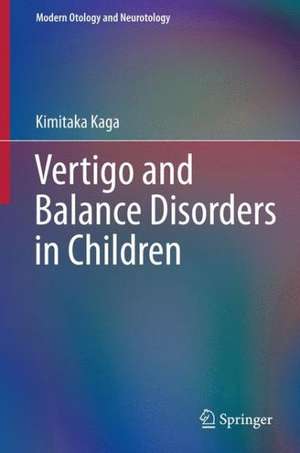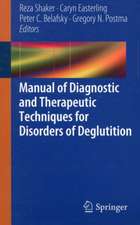Vertigo and Balance Disorders in Children: Modern Otology and Neurotology
Autor Kimitaka Kagaen Limba Engleză Hardback – 20 feb 2014
| Toate formatele și edițiile | Preț | Express |
|---|---|---|
| Paperback (1) | 579.40 lei 3-5 săpt. | +11.24 lei 7-13 zile |
| Springer – 23 aug 2016 | 579.40 lei 3-5 săpt. | +11.24 lei 7-13 zile |
| Hardback (1) | 714.46 lei 6-8 săpt. | |
| Springer – 20 feb 2014 | 714.46 lei 6-8 săpt. |
Preț: 714.46 lei
Preț vechi: 752.06 lei
-5% Nou
Puncte Express: 1072
Preț estimativ în valută:
136.72€ • 141.26$ • 113.73£
136.72€ • 141.26$ • 113.73£
Carte tipărită la comandă
Livrare economică 19 martie-02 aprilie
Preluare comenzi: 021 569.72.76
Specificații
ISBN-13: 9784431547600
ISBN-10: 4431547606
Pagini: 95
Ilustrații: IX, 86 p. 62 illus., 18 illus. in color.
Dimensiuni: 155 x 235 x 15 mm
Greutate: 0.39 kg
Ediția:2014
Editura: Springer
Colecția Springer
Seria Modern Otology and Neurotology
Locul publicării:Tokyo, Japan
ISBN-10: 4431547606
Pagini: 95
Ilustrații: IX, 86 p. 62 illus., 18 illus. in color.
Dimensiuni: 155 x 235 x 15 mm
Greutate: 0.39 kg
Ediția:2014
Editura: Springer
Colecția Springer
Seria Modern Otology and Neurotology
Locul publicării:Tokyo, Japan
Public țintă
Professional/practitionerCuprins
Introduction.- 1 History. 1.1 Flurent (France) 1.2 Ewald (Germany) 1.3 Magnus (Germany) 1.4 Andres-Thomas (France) 1.5 Tadashi Fukuda (Japan).- 2 Basic Science. 2.1 Embryology of semicircular canal and otolithic organs 2.2 Developmental physiology of vestibular organs 2.3 Pathophysiology of vestibular organs 2.4 Blood brain barrier & Blood inner ear barrier.- 3 Evaluation. 3.1 Rotation chair 3.2 Caloric test 3.3 VEMP.- 4 Development of balance and motor function. 4.1 Development of balance and motor function 4.2 Postural control 4.3 Abnormal development of righting reflex postural control and balance.- 5 Clinical medicine –Disease of Vestibular organs. 5.1 Vertigo in infants and children 5.2 Meningitis 5.3 Intoxication 5.4 Inner ear malformation 5.5 Cochlear implant and related problems.- 6 Pediatric Neurology. 6.1 Benign paroxysmal vertigo 6.2 Cerebral plasy 6.3 Deafness gene or vestibular failure gene 6.4 Low birth weight 6.5 Chromosome aberration 6.6 Others.
Recenzii
From the book reviews:
“A concise treatise divided into 7 parts … . For neurologists, ENT physicians, but also of interest to the pediatric practitioners.” (Pediatric Endocrinology Reviews (PER), Vol. 12 (1), September, 2014)
“A concise treatise divided into 7 parts … . For neurologists, ENT physicians, but also of interest to the pediatric practitioners.” (Pediatric Endocrinology Reviews (PER), Vol. 12 (1), September, 2014)
Notă biografică
Kimitaka Kaga, M.D. Ph.D, National Institute of Sensory Organs, National Tokyo Medical Center.
Textul de pe ultima copertă
Many congenitally deaf infants and children suffer vestibular failure, which produces problems with their postural control, locomotion, and gait. However it is known that these children can eventually catch up with their normal balance control status in terms of development and growth as a result of central vestibular compensation. In Vertigo and Balance Disorders in Children the author provides comprehensive and integrative information on the vestibular system. The materials presented range from the history of its study, basic anatomy and physiology of vestibular organs, and the mechanism of balance and motor function development, to clinical aspects of vestibular disorders including their evaluation and pediatric neurology. Although there have been books discussing postural responses of infants and children with vestibular disorders, this is the first to present the influence of peripheral vestibular disorders and central vestibular compensation comprehensively. This book will benefit not only practitioners in this field such as pediatric otolaryngologists, pediatricians, and neurologists treating both children and adults, but also clinical specialists such as neonatologists, physical therapists, and speech therapists, helping them to better care for patients with vestibular failure.
Caracteristici
Covers key topics in pediatric vestibular failures from the mechanism to clinical treatments Describes in detail the clinical applications of the VEMP (vestibular evoked myogenic potential), Caloric Test and Rotation Chair method for an in-depth understanding of the evaluation of vestibular disorders Addresses the needs of those working in various fields of such as pediatric otolaryngology, audiology, neurology, neonatology and rehabilitation Includes supplementary material: sn.pub/extras














